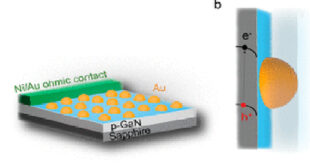Significance
Advanced microfluidic systems have broad applications in biochemical diagnostic assays, lab-on-a-chip devices, new drug delivery mechanisms, and environmental monitoring. However, the fundamental challenge in microfluidic technology is the precise control and manipulation of fluid droplets at the microscale, a task that requires a deep understanding of fluid dynamics, surface chemistry, and microfabrication techniques. Currently extensive research design more sophisticated methods for droplet manipulation, incorporating advanced materials, novel surface chemistries, and integration with digital electronics for enhanced control. To address these challenges, a new study published in Applied Physics Letters led by Professor Jiale Yong from the Department of Precision Machinery and Precision Instrumentation at the University of Science and Technology of China (USTC) and conducted by Zilong Cheng; Chaowei Wang; Xinlei Li; Tianyu Xu; Zhenrui Chen; Zehang Cui; Kangru Cheng; Suwan Zhu ; and Dong Wu, the team focused on achieving controlled unidirectional motion of water droplets on heated surfaces engineered with asymmetric microgroove arrays. These arrays were fabricated using femtosecond laser direct writing. The researchers utilized a femtosecond laser to inscribe microgroove arrays onto aluminum sheets. The laser parameters (wavelength, pulse duration, repetition rate) and scanning method (line-by-line scanning) were carefully controlled to produce the desired microgroove dimensions and spacings. They used scanning electron microscopy to analyze the morphology of the laser-induced microstructures, confirming the presence of asymmetry in the microgrooves’ profiles, which is critical for the directional motion of droplets. They designed to study how various factors such as substrate temperature, microgroove array period, droplet volume, tilt angle, and Weber number affect the kinetic behavior of droplets on the asymmetric microgrooves. High-speed cameras were used to capture the motion of water droplets on both smooth (non-treated) and laser-processed surfaces at various temperatures, enabling the team to document the transition from random to unidirectional motion as the surface temperature increased. Detailed analysis was performed to understand the mechanisms driving the unidirectional motion, particularly examining the role of the Leidenfrost effect and the viscous shear force generated by the asymmetry of the microgrooves. Indeed, this is an essential aspect of the authors’ research where they departed from traditional methods that rely on macroscopic ratchet structures for directing Leidenfrost droplet motion. These conventional techniques, while capable of guiding droplet motion, are limited by the material removal required to create the macroscopic structures and the difficulty in achieving complex shapes necessary for more intricate droplet pathways. The novel approach outlined by Yong and his team overcomes these limitations, offering a more versatile and efficient method for droplet manipulation.
The researchers successfully demonstrated that water droplets can move unidirectionally on heated surfaces with asymmetric microgroove arrays. This motion was observed when the substrate temperature exceeded a critical value, transitioning from disordered motion to directional motion. The asymmetric profile of the microgrooves was found to be essential for rectifying the water vapor ejecting from the Leidenfrost droplet, which in turn generated a viscous shear force at the droplet’s base, propelling it in a specific direction. They observed that the velocity of the droplets could exceed 318 mm/s, and droplets were capable of climbing surfaces inclined up to 14 degrees, which showcase the effectiveness of the laser-induced microstructures in controlling droplet motion. The transition from random to unidirectional droplet motion was found to be highly dependent on the substrate temperature, with a distinct threshold temperature marking the transition.
The implications of USTC scientists are far-reaching and beyond the immediate applications in droplet-based devices and thermal management, the principles elucidated in their research contribute to a deeper understanding of fluid dynamics at the microscale. Moreover, the ability to control droplet motion with such precision opens new avenues for investigating phenomena related to phase transitions, heat transfer, and surface tension effects in microenvironments. Furthermore, the adaptability of the femtosecond laser fabrication technique suggests that this approach could be tailored to a wide array of materials and application contexts. This versatility is particularly relevant in the development of lab-on-a-chip devices, where precise fluid control is paramount, and in cooling technologies for electronic components, where the ability to direct heat away from critical areas can significantly enhance performance and longevity. In conclusion, the study by Professor Jiale Yong and his team represents a significant advancement in the manipulation of fluid droplet motion on solid surfaces. They successfully utilized the unique capabilities of femtosecond laser fabrication to create asymmetric microgroove arrays, and open up new possibilities for the development of advanced microfluidic and thermal management systems.

Reference
Zilong Cheng; Chaowei Wang; Xinlei Li ; Tianyu Xu; Zhenrui Chen; Zehang Cui; Kangru Cheng; Suwan Zhu ; Dong Wu ; Jiale Yong. Designable and unidirectional motion of Leidenfrost droplets on heated asymmetric microgrooves written by femtosecond laser. Appl. Phys. Lett. 124, 061601 (2024)
 Advances in Engineering Advances in Engineering features breaking research judged by Advances in Engineering advisory team to be of key importance in the Engineering field. Papers are selected from over 10,000 published each week from most peer reviewed journals.
Advances in Engineering Advances in Engineering features breaking research judged by Advances in Engineering advisory team to be of key importance in the Engineering field. Papers are selected from over 10,000 published each week from most peer reviewed journals.


